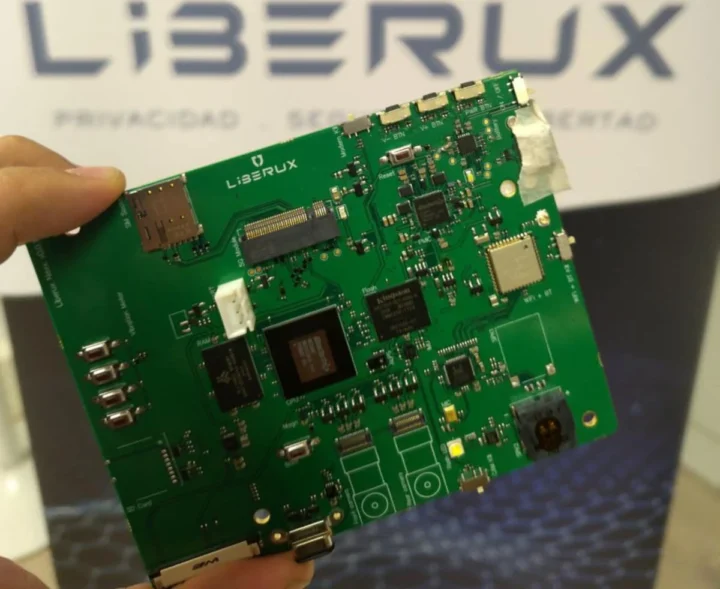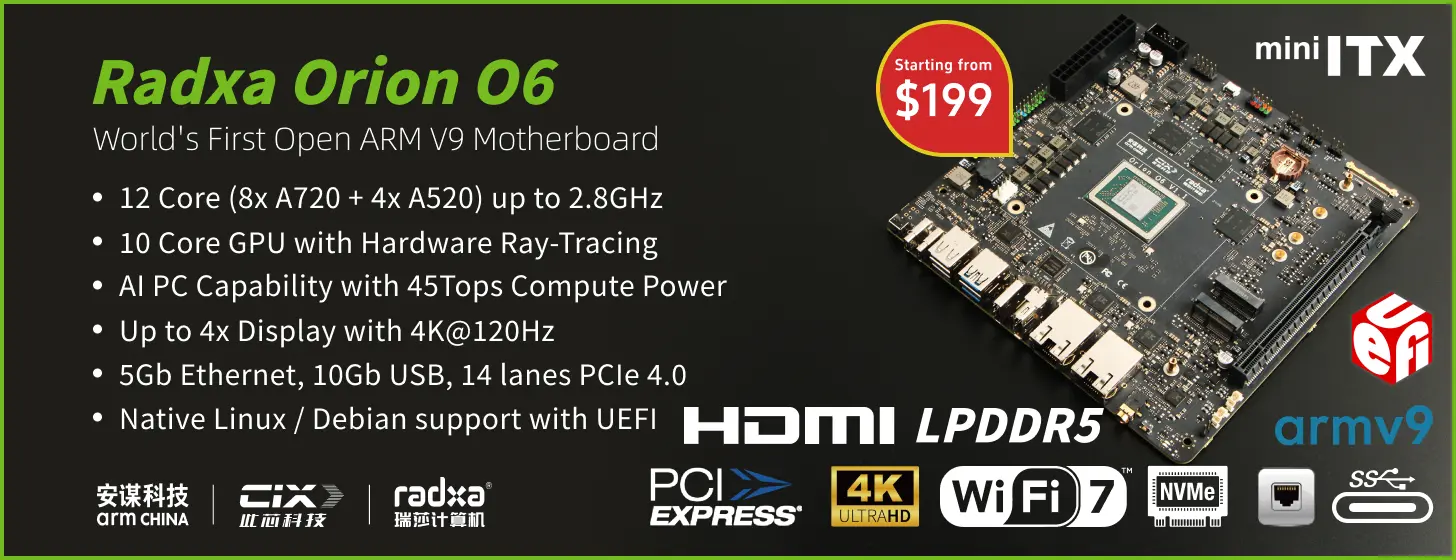Liberux NEXX is a Linux smartphone powered by a Rockchip RK3588S octa-core Cortex-A76/A55 processor coupled with 32GB LPDDR4x and a 512GB eMMC flash, as well as a 6.34-inch 2400×1080 OLED display.
We’ve seen other Linux smartphones in the past with the most popular likely being the Purism Librem 5 and Pine64’s PinePhone Pro. However, those are showing their age with older NXP i.MX 8M and Rockchip RK3399 SOCs, and the Liberux NEXX brings much-needed performance with a Rockchip RK3588S and 32GB of RAM, enabling mobile/desktop convergence to an extent.
Liberux NEXX specifications:
- SoC – Rockchip RK3588S
- CPU – Octa-core processor with 4x Cortex-A76 cores @ up to 2.4 GHz, 4x Cortex-A55 cores @ up to 1.8 GHz
- GPU – Arm Mali-G610 GPU with OpenGL ES 3.2, OpenCL 2.2, and Vulkan 1.2 support
- VPU – 8Kp60 video decoder for H.265/AVS2/VP9/H.264/AV1 codecs, 8Kp30 H.265/H.264 video encoder
- AI accelerator – 6 TOPS NPU
- System Memory – 32GB LPDDR4x
- Storage
- 512GB eMMC 5.1 flash
- MicroSD card socket up to 2TB
- Display – 6.34-inch OLED with 2400×1080 resolution
- Audio
- 3.5mm headphone jack
- ALC5640-VB-CG codec
- AW8737SCSR amplifier
- Camera
- 32MP rear camera
- 13MP front-facing camera
- Wireless
- WiFi 5 and Bluetooth 5.0 via AW-CM256SM module
- 5G cellular connectivity and GNSS (GPS, GLONASS, BeiDou, Galileo, QZSS) via Snapdragon X62 modem
- USB – 2x USB 3.1 Type-C ports
- Sensors – IMU
- STK3311-X ambient light and proximity sensors
- MMC3630KJ 3-axis magnetometer
- ICM-42670-P accelerometer and gyroscope
- Fingerprint reader
- Misc – Hardware kill switches for WiFi/Bluetooth, modem, camera/microphone, GNSS, and sensors.
- Power Supply
- 5V charging via USB Type-C port
- 5300mAh removable battery
- Dimensions – Not sure.
- Weight – Don’t know.

The Liberux NEXX will run LiberuxOS based on Debian 13 and Gnome Shell Mobile with most source code available and over 5 years of planned updates. The software will not track its users, and the phone also includes 3 physical kill switches for enhanced privacy. The NEXX will also serve as a mini PC thanks to a dock with a built-in wireless keyboard and RDP support to connect a larger monitor. Finally, we’re told the software is compatible with Android applications, thanks to container-based isolation (like WayDroid).
That’s all good so far. We can now talk about the bad and the ugly…
First, the Rockchip RK3588 Linux smartphone is just at the concept stage, or in other words, it does not exist. What they do have is the Liberux development board with all the main components that will be used in the final phone. Software is being worked on, but there’s no demo so far, even on the development board.
Linux smartphones target a niche audience, so they are expected to be pricier than their Android equivalent, but the Libreux NEXX makes the Librem 5 like a bargain, admittedly with much better specifications, as it’s offered for 1,300 Euros and up on Indiegogo with shipping adding 20 to 35 Euros depending on the destination country. You’ll have to be patient, which is not really surprising considering the stage of development, as deliveries are scheduled to start in July 2026 if the project goes accordingly to plan. Finally, the crowdfunding campaign is bound to fail because the (fixed) funding target is pretty high at €1,434,375, or about 1000 backers. Having said that, it is still lower than the 32 million dollars Canonical asked for the Ubuntu Edge smartphone in 2013… A few more details may also be found on the project’s website.
Via Liliputing.

Jean-Luc started CNX Software in 2010 as a part-time endeavor, before quitting his job as a software engineering manager, and starting to write daily news, and reviews full time later in 2011.
Support CNX Software! Donate via cryptocurrencies, become a Patron on Patreon, or purchase goods on Amazon or Aliexpress. We also use affiliate links in articles to earn commissions if you make a purchase after clicking on those links.








They must be out of their minds to think someone would pay so much for a 5 year old (by then) CPU.
I’ve been eyeing a real linux phone for some time now, but from the many opinions I’ve read from people using them, they don’t seem ready to be used as a daily driver.
e.g. https://drewdevault.com/2023/06/16/Mobile-linux-retrospective.html
One issue other people bring up is battery life. The PinePhone Pro has a decently capable chip with customized RK3399 but my understanding is it can’t carry you through half a day without a power bank.
I’d be worried that RK3588 is going to be worse in that regard. Hopefully they can also contribute to the software ecosystem, as sw maturity is the other main issue.
The phone looks cool though and having choice and higher performance devices is essential to the mobile linux efforts. Hope it succeeds!
Power consumption in suspend to RAM is about 160mW so you get 2.5 days standby reduced proportionally by max 4-6h runtime. (if you use it for 2h total, remaining standby will be 1.2 days)
ok, that doesn’t sound too bad.
is this for the rk3588s or PinePhonePro’s rk3399 ?
Is this the main SoC only or takes other components into account ?
I’m thinking of the modem here. Can the main soc sit suspended and still be responsive when calls/notifications come in ?
It’s numbers for rk3399. I don’t have any rk3588s board, but if rk3588 power consumption is of any indication, this mobile device will be a nice 1-2h early millenium notebook experience. 🙂
What is the 160 mW for? Just the CPU? Or did you include RAM (32 GB probably draws more than that just for self-refresh?), modems (at least the cellular modem in some low-power mode)…?
Another issue is that any modern phone is not running just when you actually use it. You usually still have lots of background processes running, which will wake up the CPU (and other components such as flash, modems…) regularly. Efficiently moving in and out of various power modes and activating the right cores and other components at the right times is going to be a big part of the challenge to achieve any decent battery life.
Thermal management is probably also going to be a challenge in such a constrained environment.
160mW is entire Pinephone Pro phone, measured at battery terminals, when suspended to RAM, with modem disabled.
Suspended modem should not add much to this. According to datasheet, it consumes ~9mW in that state. (I think I measured 20mW years ago.)
Are you involved in this project, Megi? Hope you’re doing well, haven’t seen anything on your xnux.eu blog for a while…
Not involved. Yes, doing well, I’m just busy with other things.
Sorry, I thought that when you gave the power consumption figures that they were for the Liberux NEXX dev board, as though you knew them because you were working on it haha!
Glad to hear it!
A device like this looks useful.
Sadly its GPU does not have full FOSS-drivers. You have to load closed source to run the GPU.
The RK3582 with its disabled GPU can run a screen without 3D acceleration with fully free software. Or you take the RK3576 that could run fully with free software.
Theorhetical you can run the RK3588s with disabled GPU the same like the RK3582 but probably all images would have the closed source part inside by default and that is sad.
What’s missing from Panfrost? I understand both userspace and kernel drivers are open-source now.
https://www.cnx-software.com/2024/07/18/panthor-open-source-driver-achieves-opengl-es-3-1-conformance-with-arm-mali-g610-gpu-rk3588-soc/
@Jean-Luc Aufranc (CNXSoft) I replied a similar comment earlier with links to Collabora’s blog posts on this subject, did it get hit by the spam filter?
Yes.
Would you mind unblocking them from the spam filter?
Also, PanVK on G610 GPUs is now Vulkan 1.2 conformant, again thanks to Collabora
If not, the titles of the two articles (so that other readers can search for them themselves) are:
“PanVK is officially Vulkan 1.1 conformant” (from 14th April 2025)
“Release the panthor!” (from 04th March 2025)
The latest update from them about PanVK being Vulkan 1.2 conformant is:
“PanVK reaches Vulkan 1.2 conformance on Mali-G610” (from 26th May 2025)
@Jean-Luc Aufranc (CNXSoft)
Just try to run it with only free software. Do not install any closed source software. It sadly do not work. I would love to see a fully opensource driver for this GPU. Until then (or maybe also still afterwards) the a Qualcom SoC could create the more modern and free systen. Take a look at the SoC that is inside the Fairphone 5. Its a awesome choice for long time support and the GPU can run with free software.
@Bil Yes, you are correct.
Because i have not mentioned it before: For example the AW-CM256SM chip build into this phone also can not run with just free software. It need closed source software to run.
The LivingLinux YouTube channel has some videos about getting different software to run hardware accelerated on the RK3588 using the FOSS GPU drivers
As for the AW-CM256SM, of course it doesn’t run FOSS because it isn’t an ATH9K…
When you look at the outstanding list of Collabora’s work for the RK3588 (without whose efforts would have already consigned the soc to veritable prehistoric status), there is still much to do to reach the milestone of a complete, all round usage. Personally I doubt that we will see this happen this year and so as time passes, interest in the SOC will wain even more.
Right now, the stop gap RK3576 that Rockchip has put out to take attention away from their latest failure does, at least seem to have the right kind of capabilities that might make it a more viable proposition.
But with advances with more open source possibilities with Snapdragon, does anyb ody really want a Rockchip based phone at all when taking into consideration the pricing.
Do we really want Qualcomm to have a monopoly?
Not convinced at all that RK3588S will make optimal use of battery life… I suspect that more performant chips designed with mobility in mind can use less power.
how do they plan to make the batterylife last more than 2 hours ?
Anyway there are no new linux phones because there are no new small SOCs lately…
… and also (more likely) because there is little demand.
Really? It seems like there are more and more Linux phones coming to market: DawnDrums Divine D., Mecha Comet, the Liberux NEXX (assuming it’s not just a get-rich-quick-scheme)…
thankyou for the info! i didnt know!
This one is excluded because im not sure i’d pay 300$, 1300 is scammy.
If a linux phone with basic features can be built and sold for $500 dollars then I think it really would be a major success. There are enough people today who now want to get as far away from google (android) and apple (ios) as they can, due to the plundering of your entire life, and all of it being fed into god knows what AI training, sold to 3rd parties, and ad/marketing morons. A fully encrypted device, with a decent comms app like signal, private and adfree web browsing, camera, music etc with private cloud access, would probably capture most customers requirments. The company could also make money on an app payment side, again with no ads, making post sale of the phone profitable. Once a few more horror stories come out soon about what the major players have been doing with peoples data, then more and more people would jump ship.
Last i heard dawndrums was targeting 600-800 USD for the divine-d with the same rk3588 chip
I don’t know if somebody has experience with the furiphone? According their website it should be a full working linux phone.
No experience (I’m sure Sword will chip in though, surprised they don’t get commission… 😉 ) but it’s not quite correct to describe it as a Linux phone; IIRC it’s a hybrid because it uses Android drivers and a compatibility layer to translate the calls between them and the system. And IIRC those drivers will be reliant on an outdated Android kernel, unlikely to see long term support – whereas mainline Linux drivers have a greater chance of LTS.